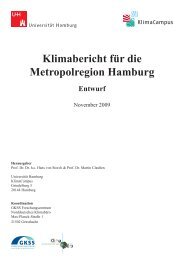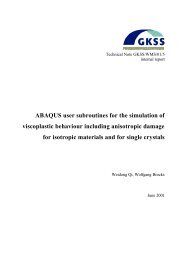Dynamics and Vulnerability of Delta Systems - loicz
Dynamics and Vulnerability of Delta Systems - loicz
Dynamics and Vulnerability of Delta Systems - loicz
Create successful ePaper yourself
Turn your PDF publications into a flip-book with our unique Google optimized e-Paper software.
Executive Summary<br />
<strong>Delta</strong>s form where rivers meet the ocean. They are then naturally shaped by the forces <strong>of</strong> rivers,<br />
waves <strong>and</strong> tides. Intricate mazes <strong>of</strong> river channels, wetl<strong>and</strong>s <strong>and</strong> coastal features, that ever-change<br />
host a wide variety <strong>of</strong> unique ecosystems. <strong>Delta</strong>s are recognized as critically important habitats<br />
for threatened terrestrial <strong>and</strong> marine species. <strong>Delta</strong>s act as filters, repositories, <strong>and</strong> reactors for a<br />
suite <strong>of</strong> continental materials, including carbon, on their way to the coastal ocean.<br />
Due to their low topography, high productivity, rich biodiversity, <strong>and</strong> easy transport along<br />
abundant waterways, deltas are preferred locales <strong>of</strong> human habitation as well. <strong>Delta</strong>s may only<br />
comprise 5% <strong>of</strong> the l<strong>and</strong> area, but over 500 million people live on them, including many heavily<br />
populated megadeltas in Asia. The Ganges-Brahmaputra, Yangtze <strong>and</strong> Nile deltas alone are<br />
extremely densely populated with 230 million people in 2000. It is expected that there will be a<br />
35% increase <strong>of</strong> population in the major world deltas by 2015.<br />
<strong>Delta</strong>s are unfortunately also fragile geomorphic features, <strong>and</strong> can change dramatically with<br />
modest modifications in the controlling environmental conditions. Already, thirty-three major<br />
deltas collectively include significant area (~26,000 km 2 ) below local mean sea level <strong>and</strong> another<br />
~70,000 km 2 <strong>of</strong> vulnerable area below 2 m. This vulnerable area may increase by 50% under<br />
projected 21 st century eustatic sea level rise. Intensive human development, population growth, as<br />
well as recent human-induced global changes are degrading deltas <strong>and</strong> <strong>of</strong>ten transforming them<br />
into increasingly hazardous coastal regions. Given current trends including shifts in climate,<br />
upstream changes in water quantity <strong>and</strong> quality, <strong>and</strong> population pressure, many deltas are in<br />
danger <strong>of</strong> collapse within the 21 st century.<br />
What would a collapse look like? A collapse may include complete loss <strong>of</strong> wetl<strong>and</strong>s <strong>and</strong><br />
concomitant biodiversity, cities <strong>and</strong> villages <strong>and</strong> the associated infrastructure flooded, permanent<br />
loss <strong>of</strong> fishing areas, farming l<strong>and</strong>s, <strong>and</strong> valuable forests, <strong>and</strong> rapid shoreline retreat. Future<br />
preservation <strong>of</strong> deltas will become increasingly difficult <strong>and</strong> costly. Restoration or maintenance<br />
will require developing integrated management strategies that incorporate extensive monitoring,<br />
focused research <strong>and</strong> complex numerical modeling as well as detailed consultation with people<br />
affecting <strong>and</strong> affected by deltas.<br />
To assess the state-<strong>of</strong>-the-art underst<strong>and</strong>ing <strong>of</strong> the changes in <strong>and</strong> vulnerability <strong>of</strong> delta systems,<br />
the following report was commissioned jointly by: 1) LOICZ, the joint IGBP (International<br />
Geosphere-Biosphere Programme) <strong>and</strong> IHDP (International Human Dimensions Programme on<br />
Global Environmental Change) Core Project entitled L<strong>and</strong>-Ocean Interactions in the Coastal<br />
Zone, 2) GWSP, an Earth System Science Partnership project <strong>of</strong> DIVERSITAS, IGBP, IHDP<br />
<strong>and</strong> WCRP (World Climate Research Program), entitled Global Water <strong>Systems</strong> Project, <strong>and</strong> 3)<br />
CSDMS, the Community Surface <strong>Dynamics</strong> Modeling System.<br />
The report discusses the changes <strong>and</strong> vulnerabilities <strong>of</strong> world deltas resulting from anthropogenic<br />
alteration <strong>of</strong> upstream freshwater <strong>and</strong> sediment inflows, anthropogenic alteration <strong>of</strong> sediment<br />
<strong>and</strong> water routing through deltas, hydrocarbon <strong>and</strong> groundwater extraction from deltas, sea-level<br />
change, <strong>and</strong> the increased frequency <strong>of</strong> extreme climate events. A conceptual framework highlights<br />
the importance <strong>of</strong> temporal <strong>and</strong> spatial scaling in deltas, <strong>and</strong> the complex interlinkages<br />
between constructive <strong>and</strong> destructive forces <strong>of</strong> pulsed energy coming from the feeding rivers <strong>and</strong><br />
the attacking ocean, <strong>and</strong> the role <strong>of</strong> extreme climate events.<br />
v





